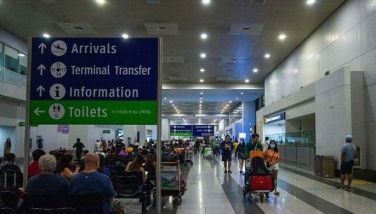What happens next?

If NAIA remains as dysfunctional as it had been these many years, it isn’t because there is no public interest to fix it. There are at least four unsolicited proposals to either fix NAIA or put up a brand-new airport from scratch elsewhere at no cost to the government.
The so-called super consortium composed of seven blue chip conglomerates has submitted a P355 billion proposal to fix and manage NAIA over 35 years. The first phase involves improving and expanding the current NAIA terminals.
The second phase involves the construction of another runway, which will raise NAIA’s capacity to serve 100 million passengers per year from the current 40 million.
But a consortium member expressed doubts this new runway could be built because of potential disruption to nearby communities. Manny Pangilinan of Metro Pacific thinks a new airport in Sangley is better.
The super consortium signed up Changi Airport of Singapore to provide the technical aspects of the proposal. The promise, according to the consortium’s official statement, is to bring NAIA up to the level of Changi.
On the other hand, Megawide Construction and its partner GMR of India submitted a more modest proposal that addresses current deficiencies of NAIA and run the facility over 18 years.
Louie Ferrer of Megawide, in an e-mailed response to my questions, dismisses the need for another runway. He said Gatwick Airport, one of several airports ser-vicing London, operates 57 movements per hour with a single runway, a point I have raised in this column for years.
NAIA, on the other hand, with two cross sectional runways only operates about 40. Ferrer thinks fixing the deficiencies in NAIA operations will produce dramatic improvements without a new runway.
In fact, Ferrer said an additional runway would even adversely affect capacity. An aircraft using that new runway will still have to cross the existing runway to get to the terminal. This will negate the advantage of unhampered operations for the main runway that most people assume. The net result is a potential reduction in total movements.
Ferrer said that by fixing deficiencies in landside, terminal and airside, they will progressively increase air traffic movements to 60 per hour by the end of Phase 1c, which is six years from start of the project. Megawide also promised to deliver the following:
“Immediately upon takeover, we will initiate capacity enhancement of the airside infrastructure including but not limited to construction of full length parallel taxiways for both runways, additional rapid-exit taxiways (RETs) and taxilanes for primary runway, extension of secondary runway, provision of maximum number of aircraft stands.
“These interventions would increase airfield capacity to 950-1000 aircraft movements/day from current 730 aircraft movements/day (a 30-35 percent increase). Our proposal entails increasing the peak hour aircraft handling capacity from 40 to 60 (a 50 percent increase).
“We would expand terminals, doubling the space resulting in a total of over 700,000 sqm of terminal area. Upon completion, both the airside and terminals shall be able to handle an annual throughput of 72 million passengers.
“Within 24 months of taking over the airport, we would rehabilitate and expand the existing terminals and improve passenger experience to bring it to IATA ‘optimum’ level of service – a standard maintained at most world class airports.
“Our detailed masterplan takes into account all the constraints in turning around a large and fully operational brownfield airport and aims to maintain the high service levels expected of a world class airport for the next 18 years.”
It is interesting that the Megawide proposal talks of fast delivery of improvements and a shorter concession period. We all know we can use quick relief from NAIA’s problems.
Megawide’s proposal also gives government time to build a new airport in another location from scratch. For example, San Miguel’s proposal to build an airport in Bulacan will not conflict with Megawide’s proposal to rehabilitate NAIA in the meantime.
While the super consortium’s proposal is also about rehabilitating NAIA, it may be offering too much given the limitations in available land for among other things, another runway.
And while Changi has built and is managing a fantastic international airport in Singapore, it doesn’t have experience in designing airports that handles domestic flights. Experts tell me there are significant differences.
Before we all start rejoicing that NAIA will soon be fixed, we have to realize that government does not have the technical expertise to evaluate all those unsolicited proposals. Indeed, my question is: how will DOTr proceed now?
The other important question is: how long will DOTr and later on NEDA take to make a decision? I don’t think NEDA has any technical expertise in evaluating proposals to build world-class airports. They just crunch financial data which should be more the concern of the private proponents since it is their money at stake.
While government lacks technical expertise, the beauty of these unsolicited proposals is that the proponents have already hired and paid for the services of international experts. It is fair to assume these proposals are technically defensible as submitted.
The fact that MIAA officials and Sec. Art Tugade succumbed to the Speaker’s demand to “rationalize” terminal assignments is worrisome. If they know their business, they shouldn’t have agreed to such a separation because it is clear the facilities available right now make that impractical and inconvenient for passengers.
So we ought to manage our expectations. The proposals of Megawide and the super consortium may make us hopeful. But in the end, we still don’t have a bureaucracy capable of picking one proposal from among the four in a way that will benefit us all.
Expect DOTr and NEDA to twiddle their thumbs for another year or so before construction can start on a new airport or rehabilitate an old one.
Boo Chanco’s e-mail address is [email protected]. Follow him on Twitter @boochanco
- Latest
- Trending



























